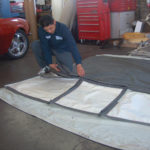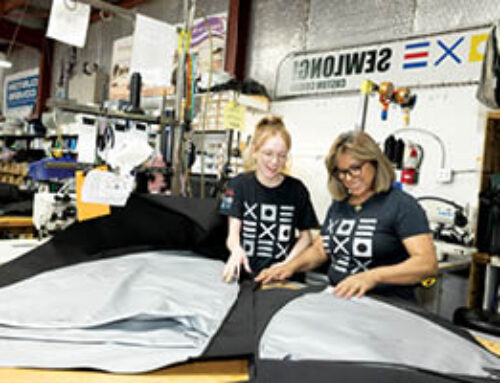Custom pilot house allows customer to see clearly
 This 1994 Monterey 265 SEL came from the factory with a substantial stock pilot house of traditional clear plastic panels secured to heavy fabric by hefty zippers. After four years of living with the stock version, the second owner of the boat, an avid yachtswoman in Southern California, decided to replace the worn and tired 14-year-old bimini and enclosure. She envisioned a new enclosure with less fabric, more “glass” and a few changes she desired from her personal experience with the Monterey.
This 1994 Monterey 265 SEL came from the factory with a substantial stock pilot house of traditional clear plastic panels secured to heavy fabric by hefty zippers. After four years of living with the stock version, the second owner of the boat, an avid yachtswoman in Southern California, decided to replace the worn and tired 14-year-old bimini and enclosure. She envisioned a new enclosure with less fabric, more “glass” and a few changes she desired from her personal experience with the Monterey.
After much conversation and negotiations to put the upholstery shop owner and the boat owner on the same wavelength, the Monterey was delivered to Bud’s Upholstery in Signal Hill, Calif. Recreating the bimini and enclosure and upgrading it with the changes the owner required, fell to fabricator and upholsterer Aaron Aguirre.
-

- Aguirre examines the 40 mil Crystal Clear 20/20, the recent generation of soft plastic for this application. The original panels show wear and tear of 14 years of service.
-

- To create the new fabric frames for each panel, Aguirre marks the original panels carefully to use as patterns before disassembling them.
-

- Aguirre then sews the Crystal Clear plastic and Seamark charcoal tweed fabric into panels as close to the original sizes and shapes as possible.
-

- The heavy-duty #4 YKK zippers are sewn into place to join the fabric panels, and to join each panel to the solid roof panel.
-

- The zippers are sewn into the Seamark, a unique fabric consisting of Sunbrella with Hartz backing. While sewing the plastic and fabric into panels, Aguirre sews protective paper into each panel to protect the plastic.
-

- A finished Crystal Clear panel covered with protective paper, which is sewn into Seamark fabric and marked for the proper location in the new enclosure. Aguirre peels away a small section of the protective paper to reveal the plastic. The paper is removed by snipping away the stitching that holds the paper in place.
-

- The paper-covered lower plastic panels are zipped in place to the bimini roof. All that remains to install the snaps at the bottom of each panel.
-

- As the lower panels are zipped into place, Aguirre begins positioning and installing the snaps to anchor the bottom of each panel.
-

- To be certain the snaps are positioned in exactly the right position, Aguirre installs the enclosure snaps at this point as the lower panels are zipped in place.
-

- To position the lower snaps perfectly, Aguirre installs them from inside the enclosure with the panels in place.
-

- The Montery takes on quite a different look with the enclosure panels in place. The protective paper covering on the Crystal Clear plastic is removed on the inside by slicing away the stitching with a single edged razor blade.
-

- Aguirre sets the lower snaps in position on the side panels. Then he snaps in the side panels to check the snap positions.
-

- Just what the customer wanted: A new enclosure with less fabric and more glass. The finished enclosure provides an open, clear atmosphere and unobstructed visibility.
-

- Aguirre walks around the enclosure and rechecks all the snaps from the outside. The last thing he does is add straps to hold the side panels up when rolled for air circulation.
-

- The boat’s original 14 years-old stock enclosure, similar to the one shown here, was worn and tired. The owner wanted a new enclosure with more visibility and a few changes based on her experience with the boat.
 TEXTILES.ORG
TEXTILES.ORG 

















